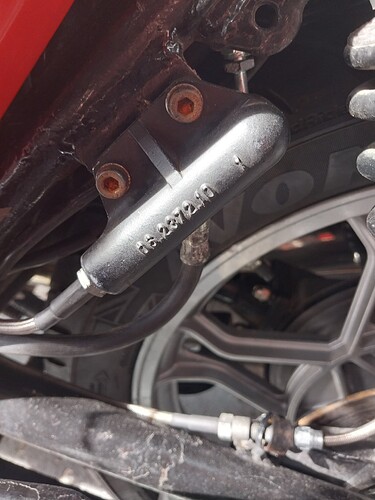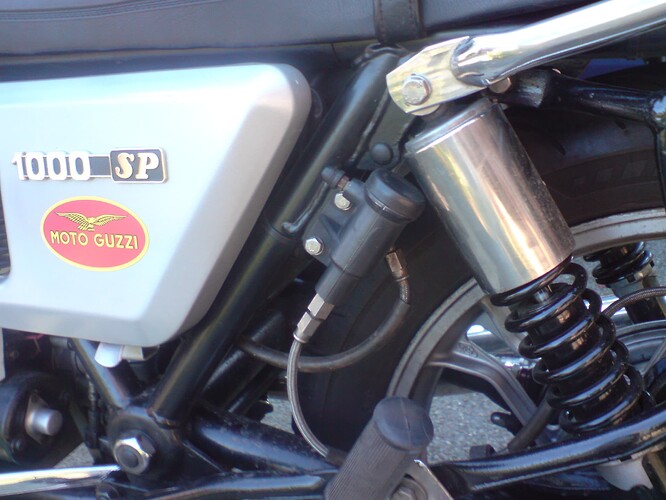Hi should my 79 sp1000 have a brake proportional valve as the one fitted doesn’t look anything like the the knes I’ve seen.
Yes it should have. But at 43 years old, many have siezed up and been replaced with a standard union that doesn’t have any moving parts.
This is what it should have fitted.
Thanks for that,I imagine the linked brakes won’t be as effective without the correct valve.
I have no idea how it works, but if I press the pedal hard, a piston rises in the top of the valve. I think it shifts more pressure to the front under hard braking.
There must have been good reason why Guzzi decided to fit it.
Its my first Guzzi so have no idea wether my brakes are working correctly, they stop me ect but I’m probably not getting the correct 'linked effect’![]()
It is only the Spada that had this set up of a proportioning vlave and a larger P9 rear caliper on the rear.
The Le-Mans, T3 etc had P8 calipers all round and a straight forward manifold like yours and they all stop pretty well.
The pv reduces pressure to the rear brake when the pedal produces 21bar. Upto this point its roughly 50/50 front rear. After this most of the additional pressure goes to the front. Some other tontis have the same set-up ie Cali 1100i. In fact theres a graph in the 1100i workshop manual showing this.
All it means is you are less likely to lock up the rear if you stomp on the rear brake.
^^ What he said (I had a Spada 1 so am familiar with it) - 50/50 front/rear distribution of braking effort when the pedal (only!) is pressed gently, then with increased pressure, more braking effort on the front, while the rear should stay the same.
However the proportioning valve only works properly with the correct grades of brake pads in the correct places. If memory is correct (but which is not reliable!) there were 3 grades of friction material - 220, 222, and 224 (these are specifically the reccommended Brembo pads). 220 being hardest, 224 being softest. I believe the single front disc (handlebar lever) was 224. Other front disc was 220, and the rear, also being the larger P9 size, was 222. (I think.) In that way, you achieved the published distribution of braking forces. If not using those grades, in the required locations, you don’t. You get something different.
My proportioning valve stopped proportioning, that is, it was just acting as a manifold for distibuting brake fluid. I took it apart, and found there is a piston, the top end of which raises a bump in the rubber cap on top. The bottom end is a shaft that is partially cut away to allow fluid to flow through what looks like a rubber grommet. As the piston raises up, the bottom end which is fully rounded (no cut-out), moves up and blocks the hole in the grommet. Or it might, if the grommet is in good condition. Mine was badly distorted due to use over about 5 or 6 years, and so the flow of fluid to the rear caliper was not being restricted. Impossible to repair, so buy a new one.
But is there any point, since it’s not possible to obtain the 3 different grades of pads, that is to say, I noticed sellers stopped stocking the 220 and 224, and I could only get the 222. This would be certainly by the 1990’s or 2000’s. I think the P9 was only ever available as 222, and subsequently the P8 also.
HTH
So there you have it Roy. Very unlikely that you would have exactly the same set-up as new. So go with what works for you and ride around the issue. I know that some say that running with a manifold works out fine. I have stainless floating discs with sintered pads on the front and standard pads on the rear (P9) and the pv and it works ok. Of course Im older and wiser now and anticipate my breaking well in advance ![]()
Thanks to all for the info having the Guzzi is certainly a learning curve,so will carry on with what’s fitted.![]()
You can always play around with different brands of pads. I found Ferodo worked well with my Le Mans 1. I notice that Gutsibits sell them, also for the P9 caliper. P8, FDB148; P9, FDB204P.
Afterwards I thought of something else - the proportioning system would naturally depend on both brakes behaving as designed, i.e. no worn or wobbly discs, wonky pads or sticking pistons, any of which of course may occur in real life!
Couldn’t agree more,p o replaced callipers and pads so not sure what I have will check them out.

